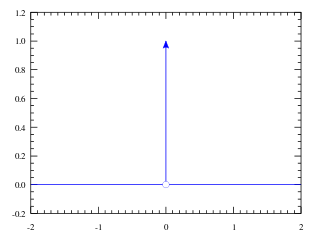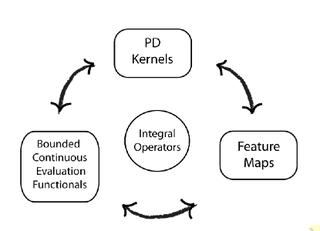This article relies largely or entirely on a single source .(December 2009) |
In mathematics, weak convergence in a Hilbert space is the convergence of a sequence of points in the weak topology.
This article relies largely or entirely on a single source .(December 2009) |
In mathematics, weak convergence in a Hilbert space is the convergence of a sequence of points in the weak topology.
A sequence of points in a Hilbert space H is said to converge weakly to a point x in H if
for all y in H. Here, is understood to be the inner product on the Hilbert space. The notation
is sometimes used to denote this kind of convergence. [1]
![The first three functions in the sequence
f
n
(
x
)
=
sin
[?]
(
n
x
)
{\displaystyle f_{n}(x)=\sin(nx)}
on
[
0
,
2
p
]
{\displaystyle [0,2\pi ]}
. As
n
-
[?]
{\displaystyle n\rightarrow \infty }
f
n
{\displaystyle f_{n}}
converges weakly to
f
=
0
{\displaystyle f=0}
. Sinfrequency.jpg](http://upload.wikimedia.org/wikipedia/commons/thumb/7/7e/Sinfrequency.jpg/350px-Sinfrequency.jpg)
The Hilbert space is the space of the square-integrable functions on the interval equipped with the inner product defined by
(see Lp space). The sequence of functions defined by
converges weakly to the zero function in , as the integral
tends to zero for any square-integrable function on when goes to infinity, which is by Riemann–Lebesgue lemma, i.e.
Although has an increasing number of 0's in as goes to infinity, it is of course not equal to the zero function for any . Note that does not converge to 0 in the or norms. This dissimilarity is one of the reasons why this type of convergence is considered to be "weak."
Consider a sequence which was constructed to be orthonormal, that is,
where equals one if m = n and zero otherwise. We claim that if the sequence is infinite, then it converges weakly to zero. A simple proof is as follows. For x ∈ H, we have
where equality holds when {en} is a Hilbert space basis. Therefore
i.e.
The Banach–Saks theorem states that every bounded sequence contains a subsequence and a point x such that
converges strongly to x as N goes to infinity.
The definition of weak convergence can be extended to Banach spaces. A sequence of points in a Banach space B is said to converge weakly to a point x in B if for any bounded linear functional defined on , that is, for any in the dual space . If is an Lp space on and , then any such has the form for some , where is the measure on and are conjugate indices.
In the case where is a Hilbert space, then, by the Riesz representation theorem, for some in , so one obtains the Hilbert space definition of weak convergence.
In mathematics, more specifically in functional analysis, a Banach space is a complete normed vector space. Thus, a Banach space is a vector space with a metric that allows the computation of vector length and distance between vectors and is complete in the sense that a Cauchy sequence of vectors always converges to a well-defined limit that is within the space.

In mathematics, an inner product space is a real vector space or a complex vector space with an operation called an inner product. The inner product of two vectors in the space is a scalar, often denoted with angle brackets such as in . Inner products allow formal definitions of intuitive geometric notions, such as lengths, angles, and orthogonality of vectors. Inner product spaces generalize Euclidean vector spaces, in which the inner product is the dot product or scalar product of Cartesian coordinates. Inner product spaces of infinite dimension are widely used in functional analysis. Inner product spaces over the field of complex numbers are sometimes referred to as unitary spaces. The first usage of the concept of a vector space with an inner product is due to Giuseppe Peano, in 1898.
In mathematics, weak topology is an alternative term for certain initial topologies, often on topological vector spaces or spaces of linear operators, for instance on a Hilbert space. The term is most commonly used for the initial topology of a topological vector space with respect to its continuous dual. The remainder of this article will deal with this case, which is one of the concepts of functional analysis.

In mathematical analysis, the Dirac delta function, also known as the unit impulse, is a generalized function on the real numbers, whose value is zero everywhere except at zero, and whose integral over the entire real line is equal to one. Since there is no function having this property, modelling the delta "function" rigorously involves the use of limits or, as is common in mathematics, measure theory and the theory of distributions.
In mathematical analysis, Parseval's identity, named after Marc-Antoine Parseval, is a fundamental result on the summability of the Fourier series of a function. The identity asserts the equality of the energy of a periodic signal and the energy of its frequency domain representation. Geometrically, it is a generalized Pythagorean theorem for inner-product spaces.
In mathematics and signal processing, the Hilbert transform is a specific singular integral that takes a function, u(t) of a real variable and produces another function of a real variable H(u)(t). The Hilbert transform is given by the Cauchy principal value of the convolution with the function (see § Definition). The Hilbert transform has a particularly simple representation in the frequency domain: It imparts a phase shift of ±90° (π/2 radians) to every frequency component of a function, the sign of the shift depending on the sign of the frequency (see § Relationship with the Fourier transform). The Hilbert transform is important in signal processing, where it is a component of the analytic representation of a real-valued signal u(t). The Hilbert transform was first introduced by David Hilbert in this setting, to solve a special case of the Riemann–Hilbert problem for analytic functions.

In functional analysis, a reproducing kernel Hilbert space (RKHS) is a Hilbert space of functions in which point evaluation is a continuous linear functional. Roughly speaking, this means that if two functions and in the RKHS are close in norm, i.e., is small, then and are also pointwise close, i.e., is small for all . The converse does not need to be true. Informally, this can be shown by looking at the supremum norm: the sequence of functions converges pointwise, but does not converge uniformly i.e. does not converge with respect to the supremum norm.
In mathematics, the spectrum of a C*-algebra or dual of a C*-algebraA, denoted Â, is the set of unitary equivalence classes of irreducible *-representations of A. A *-representation π of A on a Hilbert space H is irreducible if, and only if, there is no closed subspace K different from H and {0} which is invariant under all operators π(x) with x ∈ A. We implicitly assume that irreducible representation means non-null irreducible representation, thus excluding trivial (i.e. identically 0) representations on one-dimensional spaces. As explained below, the spectrum  is also naturally a topological space; this is similar to the notion of the spectrum of a ring.
In linear algebra, the transpose of a linear map between two vector spaces, defined over the same field, is an induced map between the dual spaces of the two vector spaces. The transpose or algebraic adjoint of a linear map is often used to study the original linear map. This concept is generalised by adjoint functors.
In mathematics, the Riesz–Fischer theorem in real analysis is any of a number of closely related results concerning the properties of the space L2 of square integrable functions. The theorem was proven independently in 1907 by Frigyes Riesz and Ernst Sigismund Fischer.
In the mathematical discipline of functional analysis, the concept of a compact operator on Hilbert space is an extension of the concept of a matrix acting on a finite-dimensional vector space; in Hilbert space, compact operators are precisely the closure of finite-rank operators in the topology induced by the operator norm. As such, results from matrix theory can sometimes be extended to compact operators using similar arguments. By contrast, the study of general operators on infinite-dimensional spaces often requires a genuinely different approach.
In mathematical analysis, a Young measure is a parameterized measure that is associated with certain subsequences of a given bounded sequence of measurable functions. They are a quantification of the oscillation effect of the sequence in the limit. Young measures have applications in the calculus of variations, especially models from material science, and the study of nonlinear partial differential equations, as well as in various optimization. They are named after Laurence Chisholm Young who invented them, already in 1937 in one dimension (curves) and later in higher dimensions in 1942.
Hilbert C*-modules are mathematical objects that generalise the notion of Hilbert spaces (which are themselves generalisations of Euclidean space), in that they endow a linear space with an "inner product" that takes values in a C*-algebra.
In functional analysis, the Dunford–Pettis property, named after Nelson Dunford and B. J. Pettis, is a property of a Banach space stating that all weakly compact operators from this space into another Banach space are completely continuous. Many standard Banach spaces have this property, most notably, the space of continuous functions on a compact space and the space of the Lebesgue integrable functions on a measure space. Alexander Grothendieck introduced the concept in the early 1950s, following the work of Dunford and Pettis, who developed earlier results of Shizuo Kakutani, Kōsaku Yosida, and several others. Important results were obtained more recently by Jean Bourgain. Nevertheless, the Dunford–Pettis property is not completely understood.

In mathematics, Hilbert spaces allow the methods of linear algebra and calculus to be generalized from (finite-dimensional) Euclidean vector spaces to spaces that may be infinite-dimensional. Hilbert spaces arise naturally and frequently in mathematics and physics, typically as function spaces. Formally, a Hilbert space is a vector space equipped with an inner product that induces a distance function for which the space is a complete metric space. A Hilbert space is a special case of a Banach space.
Coherent states have been introduced in a physical context, first as quasi-classical states in quantum mechanics, then as the backbone of quantum optics and they are described in that spirit in the article Coherent states. However, they have generated a huge variety of generalizations, which have led to a tremendous amount of literature in mathematical physics. In this article, we sketch the main directions of research on this line. For further details, we refer to several existing surveys.
In mathematics, nuclear operators are an important class of linear operators introduced by Alexander Grothendieck in his doctoral dissertation. Nuclear operators are intimately tied to the projective tensor product of two topological vector spaces (TVSs).
In mathematics, a dual system, dual pair or a duality over a field is a triple consisting of two vector spaces, and , over and a non-degenerate bilinear map .
In functional analysis, every C*-algebra is isomorphic to a subalgebra of the C*-algebra of bounded linear operators on some Hilbert space This article describes the spectral theory of closed normal subalgebras of . A subalgebra of is called normal if it is commutative and closed under the operation: for all , we have and that .
This is a glossary for the terminology in a mathematical field of functional analysis.